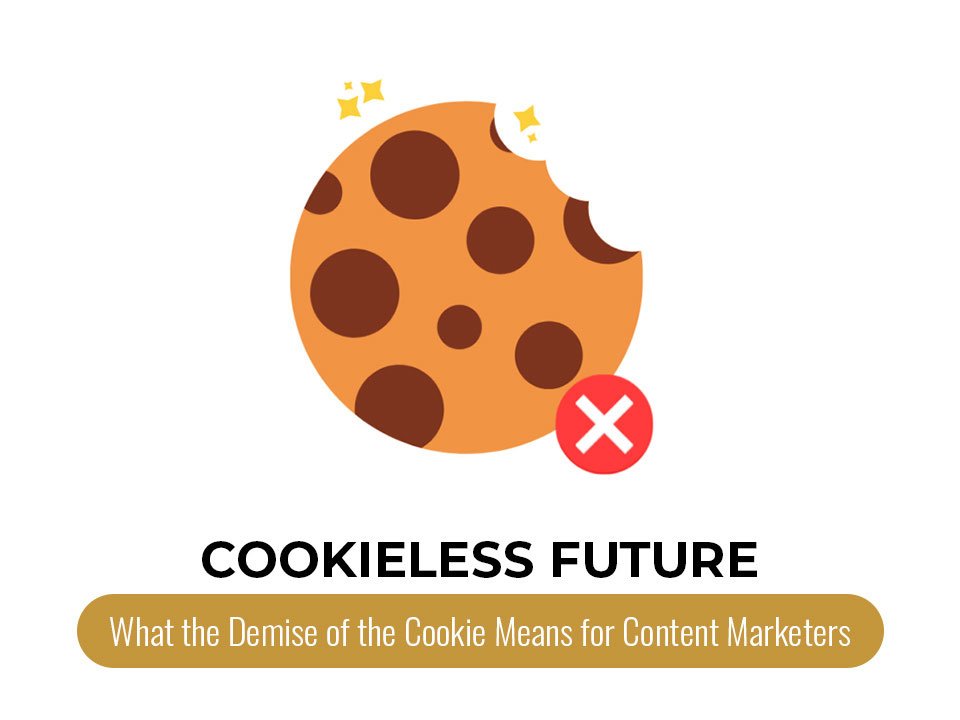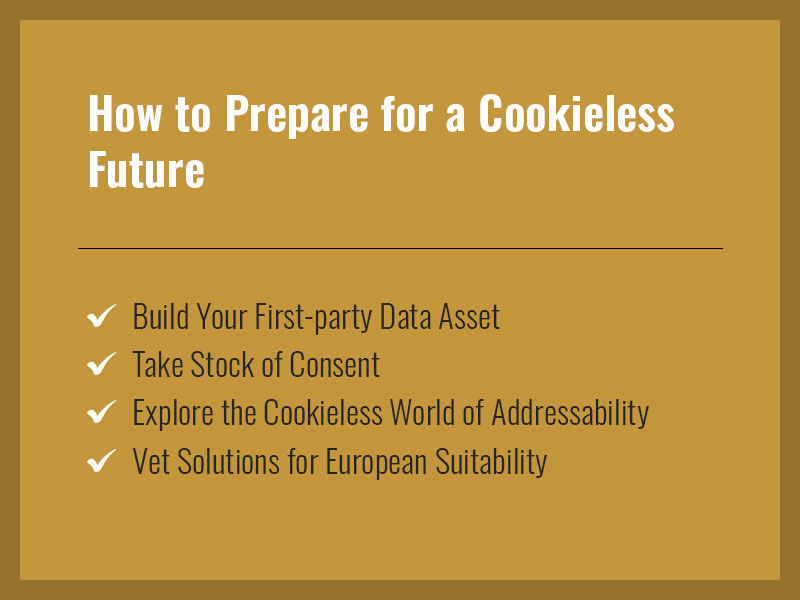
Cookieless Future: What the Demise of the Cookie Means for Content Marketers
The cookieless future of Digital Marketing is worrying many companies. In recent years, marketing experts have become used to having a massive volume of data available to support their decisions, optimize strategies, and target campaigns. However, this data may no longer be available. How do we deal with that?
More and more data is generated and collected daily in Digital Marketing as the digital age progresses. When a user clicks a link or visits a page, subtle traces are left behind. Assume, then, the size of the Big Data universe. Cookies are data that websites collect from visitors. They aid businesses in better understanding their website visitors’ profiles and enhancing their online experience.
With recent events concerning user privacy, the collection and use of data have come under fire. This has caused significant browsers such as Google Chrome to take measures against third-party cookies to protect personal information. However, this affects Digital Marketing strategies that have become reliant on browser cookies over the years. So now is the time to ask:
- What does a cookieless future look like in Digital Marketing?
- How should companies prepare themselves to work without this data in their strategies?
These changes are monumental for a market that has become accustomed to accessing this data. We will now investigate cookies—what they are and how these new updates can potentially affect your company. More specifically, we will cover the following topics:
What are Cookies?
Cookies are text files that a website sends to the browser when a user visits its site. They’re designed to keep track of important information and improve your browsing experience. Cookies are widely used on most websites and are an accepted internet practice. Cookies keep track of users’ access histories to sites and apps and their interactions (clicks, forms, passwords, etc.).
Cookies, as previously said, are small pieces of data that a website stores on your computer when you visit it. Each time the user revisits the website that transmitted the cookies, the browser sends data back to help pages load faster and include the user’s preferences and previous data. This allows, for example, websites to keep users logged in or retain items they placed in their shopping cart. Cookies also aid Digital Marketing by customizing the experience and aligning content to users’ interests and behaviors.
Differences Between First and Third-party Cookies
Both types of cookies function in the same way. They are data gathered by the website and delivered to the browser, with each user’s surfing history and actions. First-party vs. third-party cookies: The distinction is how they’re collected and what they’re used for.
The websites create first-party cookies that users visit. They collect data such as language and payment method preferences, form information like usernames and passwords, products stored in the cart, and so on. Third-party cookies are created by domains other than the ones that users visit. They are generally used for marketing and advertising purposes, as they:
- Monitor the user’s navigation between different websites (cross-site tracking)
- Direct retargeting ads, according to past behavior
- Deliver ads to various websites in an optimized way (ad serving)
Third-party cookies are the current source of debate, having been removed by some browsers, including Google Chrome. All browsers support primary cookies, although they may be disabled in the browser configuration.
Why will Cookies be Extinct?
You may have seen a warning like this when accessing a website. These notifications alert users that their data is being collected by the website they are browsing. Cookie alerts have become more common since the emergence of data protection laws, which require users to be informed that their data will be stored and what it will be used for. This concern with the privacy of users’ data motivated browsers to announce the end of third-party cookies.
According to Think with Google, searches for “online privacy” grew 50% globally in 2020 compared to the previous year. This means there is a global concern about this issue. And Google Chrome is said to be responding to this demand with its plans to remove support for third-party cookies. In general, cookies are harmless and can only be used to improve your experience on websites. The problem is that third-party cookies may not guarantee the security and protection of user’s data, which affects transparency in their processing.
One risk to protecting personal data is that companies may sell the information they collect to other businesses without users knowing. From then on, the use becomes unlawful, even if they only use the data for advertising purposes. This has already happened, for example, in the Cambridge Analytica case, which reinforced the warning about this type of practice.
According to a Pew Research Center survey published on Google’s blog, 72% of people feel that everything they do on the internet is tracked. Furthermore, 81% say the potential risks of using their data outweigh the benefits.
That’s why Google Chrome and other browsers are committed to eliminating third-party cookies and building a privacy-first web — even if it means transforming the current marketing and advertising marketplace.
What Does the End of Cookies Mean?
When we talk about a cookieless future, we’re talking about the end of third-party cookies. It is possible to build a web with cookies and Big Data transparently and securely. But to do that, we need to reshape how the internet and Digital Marketing have worked in recent years.
Below, we’ll look at how the end of cookies will affect Google, advertisers, and users in the coming years. Check it out:
For Google
Google, through its Chrome browser, has joined the cookieless movement. But the company itself knows it will be affected. After all, Google’s search engine uses users’ cookies to personalize and optimize their search experience based on data from the most accessed pages and the searches they perform.
For Advertisers
For advertisers, the end of third-party cookies is far from the end of online advertising. But it is undeniable that this change brings essential impacts, such as reducing the user data available and adopting new mechanisms — with more transparency and security assurance for users — to obtain data.
For Users
For users, a cookieless future in Digital Marketing tends to bring more security to their data while browsing the web. This is the intention of this whole movement. On the other hand, the impacts of online advertising could also mean a browsing experience that is less personalized and relevant to your interests — at least until the marketing industry adapts to this transformation.
Read more: HOW TO CREATE A WEBSITE FOR YOUR REAL ESTATE BUSINESS: TIPS FROM THE PROS
Why Should You Care About the Cookieless Future?
As a marketer, you undoubtedly have hundreds of competing objectives – each is critical, with an imminent revenue impact. So you might be forgiven for thinking why you should care about something that happens in two years – but reconsider. Here’s why.
The elimination of third-party cookies overturns the digital advertising landscape on its head. Their abandonment disables serving online advertisements, retargeting, and cross-domain tracking in their tracks.
If your activity relies on any of these elements, think about what your results and revenue would look like if they disappeared overnight – because that’s what’s about to happen.
The Cookieless Future is in 2023 – Surely You can Wait?
Before you consider kicking the can down the road and saving your cookieless world preparations until much later, there’s one thing you should consider: even Google needed an extension on the deadline. The deadline that they set themselves.
If Google, with its near-infinite resources, realized that preparing for the cookieless future was going to need not just another six months but another two years, then alarm bells should ring for the rest of us with slightly more humble roots. This means that the delay in the cookieless future shouldn’t be viewed as a reason to procrastinate, but instead more as a warning that every minute will count in making sure you’re ready.
How to Prepare for a Cookieless Future

So, what do you do? Here are our four top pieces of advice, based on helping marketers worldwide–from Virgin Media to Heineken – prepare for the cookieless world.
1. Build Your First-party Data Asset
When one kind of data disappears, the smartest thing to do is slightly obvious: get it from somewhere else. Regarding the cookieless future, that third-party data needs to be replaced with first-party data.
What is first-party data? That’s the data you collect directly from your existing customers or prospects. Good examples included newsletter subscriptions and purchase histories, and you could also have behavioral data from your website or app.
With a well-organized first-party data asset, you can create a single customer view of a customer’s attributes and actions, helping you create more accurate segments and resolve their identity across their multiple devices and identifiers. All that adds to a better ability to effectively target your various marketing channels.
However, this is a little easier said than done – to do it; you’ll need a Customer Data Platform that ingests data from multiple sources, unifies it, and then allows you to activate it (such as creating segments and pushing those segments to other tools in your marketing stack). Next-generation ones, such as Zeotap’s Customer Data Platform, can help you do so while keeping data privacy and compliance locked down. Speaking of which.
2. Take Stock of Consent
As you navigate the cookieless future and begin to build up a first-party data asset of your own, you need to remember precisely why third-party cookies were being taken away in the first place: because they damaged consumer trust.
Third-party cookies created the impression of being ‘followed’ through the internet and made the lines of consumer control over their data blurry. All of that added up to a breakdown in trust between consumers, advertisers, and publishers – and that’s why cookies are going away. That means that whatever approach you take in a cookieless future, you need to ensure that you don’t repeat the same mistake.
In practice, that means ensuring that in the data you collect and use going forward, you need to ensure that you’re capturing and reflecting consumer consent. However, this is similar to our previous point about unifying first-party data – it’s easier said than done. After all, approval for an individual user can be captured in many different places – for example, when they sign up for a newsletter or create an account – to be on top of it, you need to unify these different sources.
At the other end of the spectrum is the challenge of how consent is reflected when executing on that data. Setting up safeguards so that you can easily ensure that information is only being used on the appropriate channels and for the right reason can often require a Data Protection Officer (DPO) to give oversight every time you set up a campaign – which poses enormous challenges of scale.
There are two necessary steps to overcome these challenges. First, audit your consent capture processes much as you likely did when GDPR came into force a few years ago – investing in Consent Management Platforms (CMPs) is worthwhile. Secondly, explore how consent mastering and consent orchestration are done in your data management processes – a good CDP should have this baked in.
3. Explore the Cookieless World of Addressability
First-party data is a big part of the cookieless future, but it’s not the whole picture. In the absence of third-party cookies, a whole host of different targeting methods are springing up to fill the void – and you now have two years to find out which ones will work for you.
The complete list of all of these – and their respective pros and cons – is an encyclopedia unto itself, but here’s a quick primer of the kind of things to look out for:
- Contextual Targeting: Yes, it’s making quite the comeback. This is the practice of advertising on a website relevant to your audience’s interests or characteristics.
- Cohort-based: If you’ve heard acronyms like FLoC (Federated Learning of Cohorts), then this is what they’re referring to – this targets people with similar browsing habits (in theory protecting their anonymity while providing advertisers with accuracy)
- Probabilistic: This is called ‘fingerprinting,’ essentially using a user’s metadata to build a targetable profile.
- Authenticated Users: If you’ve heard of ‘Universal Identifiers,’ this is the same thing – these are ‘premium’ audiences because they’ve readily ascertained themselves on a publisher’s website.
- The Walled Gardens: Facebook, Snapchat, and their kind. You know the drill.
As you can see, this landscape has suddenly become much more complex. Understanding it is one thing. Testing is quite another – now’s the time to ensure you have the resource and the budget to try them out and create a new toolset that will guide your campaigns into the cookieless future.
4. Vet Solutions for European Suitability
With the delay to the cookieless future, the elephant in the room was Europe. Keen followers of the developments may remember that back in March 2021, Google suddenly announced that it was putting origin testing of FLoC on hold in Europe. This was when alarm bells started to ring.
FLoC (Federated Learning of Cohorts) is Google’s proposed alternative to third-party cookies. It was widely interpreted that testing was suspended in Europe because of the concerns around GDPR and the ePrivacy Directive. While many were unsurprised, it was proof positive of a broader problem: most ad tech and martech solutions are created in North America. They are ill-prepared for the harsher privacy, and security regulations seen in Europe.
For marketers based in – or operating in – Europe, take this as an essential lesson in your preparation for the cookieless future. Don’t assume that the promised solutions are up to scratch for Europe – make sure you ask the right questions and have your Data Protection Officer on standby to dig deeper.
How Can Your Company Prepare for a Cookieless Future in Digital Marketing?
If you base your decisions and strategies on third-party cookies, it is essential to start adapting. Google Chrome has promised to phase out third-party cookies by 2023. Here are some guidelines:
Collect Data Directly from Consumers
Instead of relying on third-party cookies, explore other data collection mechanisms that deal directly with consumers. For example, you can run market research, satisfaction surveys, and social media polls. Also, offer free interactive content or valuable materials in exchange for user data. This way, you build a closer and more direct relationship with consumers without compromising their data protection.
Be Transparent
In the face of concerns about personal data privacy and data protection guidelines’ validity, there is no other way to relate to users: brands need to be transparent. There is no more room for shady attitudes that hide the real reasons for collecting users’ data. They need to know how and why you want to manage their data. This is not only a legal obligation now but also a way to build a trusting relationship with consumers.
Create a Privacy Policy
The privacy policy is also an obligation defined by the data protection guidelines in many countries. It must be accessible on the website, in clear and transparent language, and provide information about the uses and purpose of user data collection. People should also know how to exercise control over their data — to opt out of the company’s records or delete certain information from their registration, for example.
And these actions should be easy and quick for the user to do.
Read More: HOW IMPORTANT IS SEO IN THE FIELD OF DIGITAL MARKETING?
What are the Best Alternatives to Replace Cookies?
Ok, but if browsers are proposing a cookieless future for Digital Marketing, what are the alternatives? Google knew this move would be impactful for the advertising industry and initiated the Privacy Sandbox, which brings together a series of internet-wide measures to define operational parameters for digital advertising that ensure user privacy.
Among the proposals is the FLoC (Federated Learning of Cohorts) algorithm. This technology aims to gather users into large groups (cohorts) with everyday browsing habits and then target relevant ads based on their characteristics and interests. This way, the algorithm can blend individuals into large crowds of people with common interests. Thus, companies would not access individualized data, only cohorts.
Furthermore, as an alternative to the “cookieless future,” Google recommends strengthening first-party data. In a world that privileges privacy, it is essential to establish close and direct relationships with customers instead of relying on third parties. For marketing, this relationship strengthens users’ trust in brands and offers them a more meaningful and engaging experience throughout the buyer’s journey.
The Bottom Line
The countdown is happening in earnest – lest we forget, third-party cookies have already disappeared on Safari and Firefox, so technically the cookieless future is already here!
As a marketer, this means that there’s not a minute to waste in getting ready for the new world of digital marketing. This involves building up a solid, consented first-party data asset and assembling a whole new suite of addressability solutions where previously there was just one (third-party cookies).
To that end, it’s best to continue preparation in earnest. And if you need help, you know where to find us.


